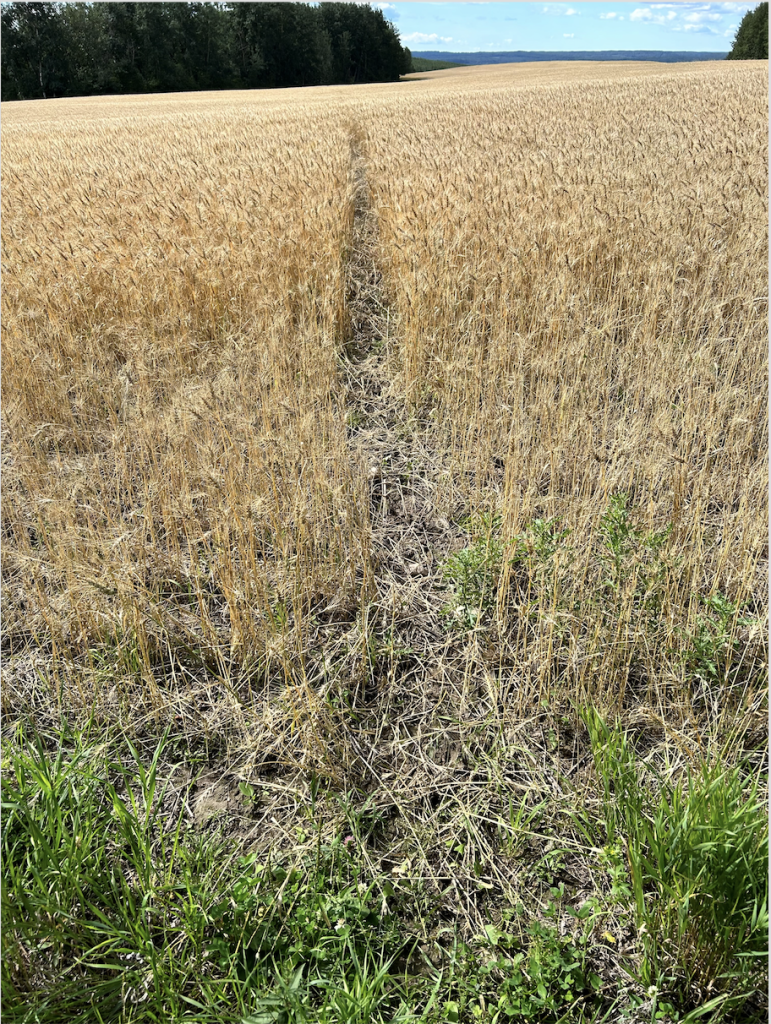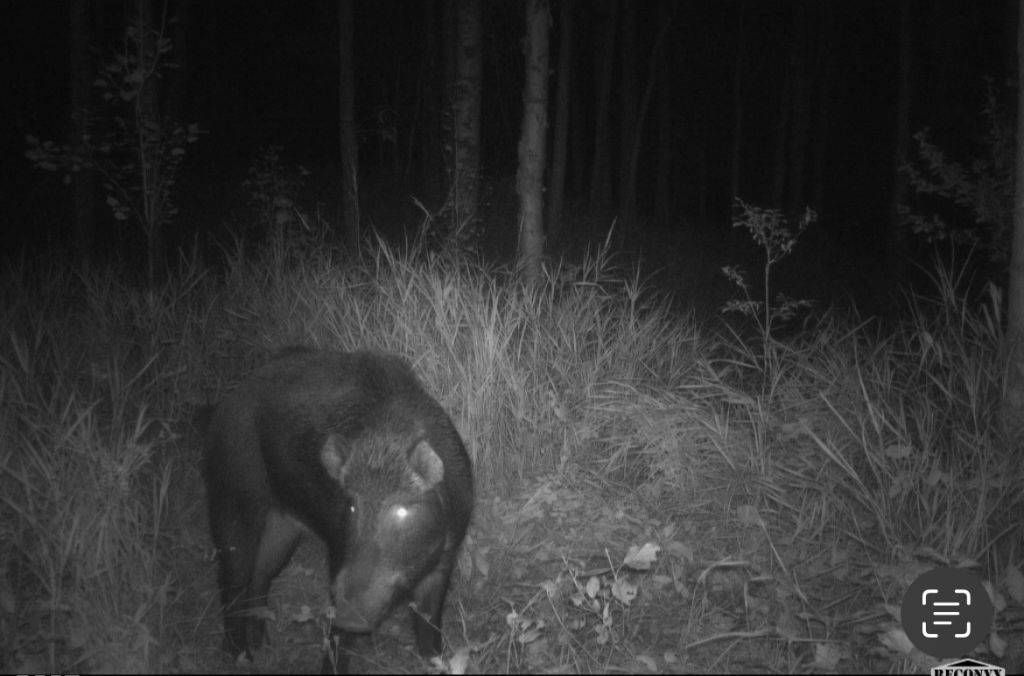
Allies in Alberta’s battle against free-roaming wild boars – university researchers, hog producers, grain farmers, wildlife groups and beyond – are adding more weapons and expanding their territory.
Expanding the trapping and monitoring program east to Alberta’s boundary with Saskatchewan was a major focus during the past summer, says Charlotte Shipp, industry programs manager for Alberta Pork. The swine producers’ corporation collaborates with universities, provincial government departments, Ducks Unlimited, Alberta Invasive Species Council, Elk Island National Park and various livestock commodity groups.
“The big key there is that we can now get to Eastern Alberta because that was a spot that we weren’t spending enough time in previously, just because we didn’t have enough resources,” Shipp said in a recent interview with Prairie Hog Country.
“We want to essentially monitor our border and make sure that we don’t have pigs coming in from Saskatchewan. And then we also want to make sure that we’re understanding the distribution of pigs out in that area as well.”
Outside the damage inflicted on cropland and water sources, cattle producers recognize the potential for wild boar to spread disease, she said. Beef and dairy producers may not have direct concerns about African Swine Fever, but they are deeply concerned about other reportable diseases, especially foot and mouth.
Along with expanding the coverage area, the collaborators have now found funding to bring two more contractors into the eradication program.
“Now we have four different eradication specialists working in different locations throughout the province,” said Shipp.
“We brought up (two experts) from the (United) States to do some training for our new eradication specialists, so that took all of this summer, but we really haven’t killed too many pigs this summer because there’s been lots of feed and lots of room for them to move around. Our capture numbers haven’t changed too much over time here, but as we look towards the close of hunting season and harvest finishing up, we should start to see that change here right away.”
Hunting season shuts down eradication and monitoring, but that does not create slack time for the program.
“We shift our focus, so we’ll go more in surveillance. We’ll look to new areas, we’ll make new landowner contact, we’ll scout out areas that are maybe newer to us and look for evidence, see if we can see how their behaviours are changing,” said Shipp.
That all changes in December, when the hunters have gone home and food sources are becoming scarce. Those four coldest months from December through March are prime time for tracking wild boars, she said.
While the contractors head out with their traps, researchers plan to collar a few “Judas” males that are neutered and then released in the hope they will root out family groups of females, known as sounders. Shipp also hopes to see some research in the effectiveness of two different types of traps. The Jager Pro trap is used to lure a sounder into a large net, with a gate closed by an operator working with a cell phone. The Pig Brig is a self-triggered trap, which encloses the pigs as they begin to root.


Expanding the program also includes the purchase of more cameras, both for research purposes and to help find pig activity.
Five of the roughly 80 cameras are installed on farms where sightings have been reported.
The rest are placed in a grid system across known pig habitat to help locate pigs and to watch for behavioural trends.
“What these grids are going to do is help us to establish what the population looks like in a specific area,” said Shipp.
“Obviously, we can’t put a camera grid up through the whole province. But in key areas where we’re working, we’re building some grids so that we can get an understanding of what that pig density looks like in the area and then it will also help us to monitor and measure our eradication effort against the overall population of the area. We just need to give it a little bit more time so we can start actually collecting that data.”
She said pig population densities vary from county to county, but she cannot reveal where densities are highest because the collaborators don’t want to attract anyone who might disrupt their efforts by hunting and shooting wild pigs.
A lack of supporting legislation to restrict wild boar hunting is still one of the biggest obstacles facing the battle against feral pigs, because it has such a huge impact on monitoring and eradication efforts, said Shipp.
Pigs that have dodged a hunters’ bullet change their habits to avoid future confrontations, spreading out further and becoming more nocturnal in their habits, she said.
“The pork industry and actually all the agricultural commodities are aligned in needing to see legislative change to prohibit the recreational hunting of wild boars at large because this will make them more educated to human activities. It will spread them and make it harder and harder to eradicate them,” said Shipp.
Based on observations to date, people working within the group believe most of the wild boars are escapees and their descendants from Alberta farms.
There has been limited hybridization between wild boars and escaped domestic pigs, which fall under different legislation, she said.
“You see the odd escapee from pasture pig type things, but those pigs do fall under a different legislation because those are now stray livestock. We do try to differentiate between livestock that has been escaped versus wild boar and we of course are focusing our efforts on these wild boars.”

Shipp commented that the wild pig program has continued to evolve in the two years since its inception and is still in its early stages.
“We’ll be continuing to look in Eastern Alberta for quite some time as well, but it’s important to monitor to see what’s coming in. We still believe that our populations here are coming from our own farms and that’s what’s formed our natural populations. We haven’t detected anything that would change that thinking as of yet.”
She commented that increased public awareness, particularly as wild boars started to appear within the boundaries of Elk Island Provincial Park, has helped raise support for the program.
“The important thing for pork producers to know is that we are working very hard and collaboratively with all of the district jurisdictions involved in Alberta and across Western Canada to try to get ahead of this issue. Because of that ASF risk, I think they can be very proud to see how much we’ve grown this initiative. Really, we just started this in 2022, and to be here in 2024 now with partnerships with Elk Island National Park and one emerging with Ducks Unlimited, with the U of C and University of Alberta and King University; I look at the amount of research we have now underway, the tools that we have and the fact that we’ve actually been able to expand.”
Still, there are no confirmed data on how many wild boars are running at large across the Prairie Provinces. The collaborators hope to get the animals under control before the populations here become the menace facing Texas, where the damages include collisions – sometimes fatal – with motor vehicles.
Shipp asked that people continue to “Squeal on Pigs” by reporting sightings or other evidence of activity. Pork producers are welcome to contact her at albertapork.com, where her phone number and email are available. Sightings can also be reported at a regional Squeal on Pigs website (abinvasives.ca/squeal-on-pigs in Alberta) or to the appropriate municipality. •
— By Brenda Kossowan





